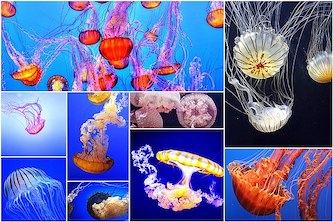The Marine Conservation Society has reported a 32% increase in jellyfish sightings in UK waters and on beaches over the past year. The most commonly spotted jellyfish were the large barrel jellyfish, but rarer warm-water crystal jellyfish were also observed. This increase in jellyfish populations is attributed to climate change, which has caused a marine heatwave and raised UK water temperatures by 3-4C in June.
The annual wildlife-sightings report by the Marine Conservation Society is based on public submissions through an online form or app. From October 2022 to September 2023, jellyfish sightings increased by 32%, with most sightings occurring on the west coasts of the UK, particularly in Cornwall and Wales. The survey also reported large blooms of more than 100 jellyfish.
The increase in jellyfish sightings may be part of a 20-year cycle, but it is also indicative of the impact of climate change on marine life. Dr. Abigail McQuatters-Gollop, a plankton expert at the University of Plymouth, noted an abundance of jellyfish this year, including the crystal jellyfish, which is not typically found in UK waters. The warmer waters resulting from climate change may be contributing to the proliferation of jellyfish in the UK.
The long-term effects of warmer UK seas are predicted to alter the country’s fish stocks as the food that sustains current fish species will change. Additionally, the survey also reported an increase in turtle sightings, with four of them being leatherback turtles. The public is advised to avoid touching jellyfish or turtles and to report sightings to the Marine Conservation Society.
In conclusion, the increase in jellyfish sightings in UK waters is a concerning indication of the impact of climate change on marine ecosystems. The warming of UK seas is creating favorable conditions for jellyfish proliferation, and further research is needed to understand the long-term implications of this trend.
Original news source: Boom in unusual jellyfish spotted in UK waters (BBC)
Listen
Slow
Normal
Fast
Group or Classroom Activities
Warm-up Activities:
– News Summary
Instructions: Students will work in pairs to summarize the article in their own words, focusing on the main points. They should aim to present their summary in under two minutes to the rest of the class. Encourage them to use new vocabulary they’ve learned from the article.
– Mind Map
Instructions: Divide the class into small groups and provide them with a large sheet of paper. Students will create a mind map centered around the topic of “Marine Life and Climate Change,” using information from the article. They should branch out to include causes, effects, and specific examples like jellyfish and turtles. This will help them organize their thoughts visually and make connections between different pieces of information.
– Opinion Spectrum
Instructions: Line up the students on one side of the room. Read out statements related to the article, such as “Climate change is the biggest threat to marine biodiversity,” and have students move along the spectrum from “strongly agree” to “strongly disagree” based on their opinion. Once they’ve positioned themselves, ask individuals from different points on the spectrum to explain their reasoning.
– Future Predictions
Instructions: Ask students to write a short paragraph predicting the future of UK marine life if current climate trends continue. They should consider the information from the article and use conditional structures (e.g., “If the water temperatures keep rising, we might see…”). After writing, they can share their predictions with a partner and discuss similarities and differences in their views.
– Vocabulary Pictionary
Instructions: Write down key vocabulary words from the article on slips of paper (e.g., “conservation,” “marine heatwave,” “plankton,” “ecosystem”). Students will take turns drawing the words for their team to guess without speaking or writing any part of the word. This activity helps reinforce new vocabulary in an engaging way and ensures that students understand the meaning of the words in context.
Comprehension Questions:
1. By what percentage did jellyfish sightings increase in UK waters over the past year according to the Marine Conservation Society?
2. What were the two types of jellyfish most commonly spotted in the UK waters?
3. By how much have UK water temperatures risen in June due to climate change?
4. How does the Marine Conservation Society collect data for its annual wildlife-sightings report?
5. During which months did the 32% increase in jellyfish sightings occur, according to the report?
6. What does Dr. Abigail McQuatters-Gollop attribute the abundance of jellyfish in UK waters to?
7. What impact are the warmer UK seas predicted to have on the country’s fish stocks?
8. How many turtle sightings were reported, and what species were they?
Go to answers ⇩
Listen and Fill in the Gaps:
The (1)______ Conservation Society has reported a 32% increase in jellyfish sightings in UK waters and on beaches over the past year. The most commonly spotted jellyfish were the large barrel jellyfish, but rarer warm-water (2)______ jellyfish were also observed. This increase in jellyfish populations is attributed to climate change, which has caused a marine (3)______ and (4)______ UK water temperatures by 3-4C in June.
The annual wildlife-sightings report by the Marine Conservation Society is based on public submissions through an online form or app. From October 2022 to September 2023, (5)______ (6)______ increased by 32%, with most sightings occurring on the west coasts of the UK, particularly in Cornwall and Wales. The survey also reported large (7)______ of more than 100 jellyfish.
The increase in jellyfish sightings may be part of a 20-year cycle, but it is also indicative of the impact of (8)______ change on marine life. Dr. Abigail McQuatters-Gollop, a plankton expert at the University of Plymouth, noted an abundance of jellyfish this year, including the crystal jellyfish, which is not typically found in UK waters. The warmer waters resulting from climate (9)______ may be contributing to the proliferation of jellyfish in the UK.
The long-term effects of warmer UK seas are predicted to alter the country’s fish (10)______ as the food that sustains (11)______ fish (12)______ will change. Additionally, the survey also reported an increase in turtle sightings, with four of them being leatherback (13)______. The public is advised to avoid touching jellyfish or turtles and to report sightings to the Marine Conservation (14)______.
In conclusion, the increase in jellyfish sightings in UK waters is a concerning indication of the impact of climate change on marine (15)______. The warming of UK seas is creating favorable conditions for jellyfish proliferation, and (16)______ research is needed to understand the long-term implications of this trend.
Go to answers ⇩
Discussion Questions:
Students can ask a partner these questions, or discuss them as a group.
1. What is your opinion on the role of citizen science, like the public submissions to the Marine Conservation Society, in contributing to environmental research?
2. How do you think the increase in jellyfish populations might affect local fishing communities and their livelihoods?
3. What are some possible consequences of marine heatwaves on aquatic ecosystems that concern you the most?
4. Do you think that the rise in sea temperatures is an issue that can be effectively addressed by individual actions, or does it require larger systemic changes? Why?
5. How would you feel if a beach you frequently visited became overrun with jellyfish blooms?
6. What is your stance on the importance of marine conservation in the face of climate change?
7. Do you believe that the reported increase in turtle sightings is a positive sign for marine biodiversity, despite the circumstances that might be causing it?
8. How do you think the changing marine environment will affect the future of tourism in coastal areas?
9. Do you like the idea of using an app to report wildlife sightings, and would you participate in such a citizen science project? Why or why not?
10. What is your perspective on the balance between enjoying marine wildlife, like turtles, and maintaining a safe distance to protect both the animals and humans?
11. How would you feel if the fish species commonly found in your local waters changed due to the warming seas?
12. Do you think that the presence of rare warm-water species like the crystal jellyfish in new areas is an exciting opportunity for research, or is it more of a concern for the native ecosystem? Why?
13. What measures do you think could be taken to mitigate the effects of climate change on marine life?
14. How do you think the proliferation of jellyfish will impact the overall health of the oceans?
15. Do you think there is enough public awareness about the effects of climate change on marine ecosystems, and if not, how could it be improved?
Individual Activities
Vocabulary Meanings:
Match each word to its meaning.
Words:
1. jellyfish
2. increase
3. climate
4. sightings
5. marine
6. temperatures
7. survey
8. impact
Meanings:
(a) A rise in the number or amount of something
(b) The act of seeing or catching sight of something
(c) The long-term pattern of weather conditions in a particular area
(d) A detailed study to gather information
(e) Relating to the sea or ocean
(f) The effect or influence of one thing on another
(g) A type of gelatinous sea creature
(h) The degree of hotness or coldness of a body or environment
Go to answers ⇩
Multiple Choice Questions:
1. What is the main reason for the increase in jellyfish sightings in UK waters?
(a) Pollution
(b) Overfishing
(c) Climate change
(d) Natural cycle
2. Which type of jellyfish was most commonly spotted in UK waters?
(a) Large barrel jellyfish
(b) Crystal jellyfish
(c) Lion’s mane jellyfish
(d) Moon jellyfish
3. Where were most jellyfish sightings reported in the UK?
(a) West coasts, particularly in Cornwall and Wales
(b) East coasts, particularly in Norfolk and Suffolk
(c) Northern coasts, particularly in Scotland
(d) Southern coasts, particularly in Devon and Dorset
4. How much did jellyfish sightings increase over the past year?
(a) 20%
(b) 32%
(c) 45%
(d) 10%
5. Who is Dr. Abigail McQuatters-Gollop?
(a) A marine biologist at the University of Oxford
(b) A climate scientist at the University of Cambridge
(c) A conservationist at the University of Manchester
(d) A plankton expert at the University of Plymouth
6. What is the long-term effect of warmer UK seas on fish stocks?
(a) Decreasing the number of fish species
(b) Increasing the size of fish species
(c) None of the above
(d) Altering the food that sustains current fish species
7. What should the public do if they spot jellyfish or turtles in UK waters?
(a) Touch the jellyfish or turtles
(b) Take pictures and post them on social media
(c) Report sightings to the Marine Conservation Society
(d) Collect the jellyfish for research purposes
8. What is the main concern about the increase in jellyfish sightings in UK waters?
(a) The decrease in fish populations
(b) The impact of climate change on marine ecosystems
(c) The danger to swimmers and beachgoers
(d) The potential for jellyfish overpopulation
Go to answers ⇩
True or False Questions:
1. The public is not advised to avoid touching jellyfish or turtles and to report sightings to the Marine Conservation Society.
2. Climate change has not caused a marine heatwave and raised UK water temperatures by 3-4C in June.
3. The annual wildlife-sightings report by the Marine Conservation Society is based on public submissions through an online form or app.
4. The most commonly spotted jellyfish were the large barrel jellyfish, but rarer warm-water crystal jellyfish were also observed.
5. From October 2022 to September 2023, jellyfish sightings increased by 32%, with most sightings occurring on the west coasts of the UK, particularly in Cornwall and Wales.
6. The short-term effects of warmer UK seas are predicted to have no impact on the country’s fish stocks as the food that sustains current fish species will remain unchanged.
7. The Marine Conservation Society has reported a 32% increase in jellyfish sightings in UK waters and on beaches over the past year.
8. Dr. Abigail McQuatters-Gollop, a plankton expert at the University of Plymouth, noted a scarcity of jellyfish this year, including the crystal jellyfish, which is commonly found in UK waters.
Go to answers ⇩
Write a Summary:
Write a summary of this news article in two sentences.
Check your writing now with the best free AI for English writing!
Writing Questions:
Answer the following questions. Write as much as you can for each answer.
Check your answers with our free English writing assistant!
1. What percentage increase in jellyfish sightings has the Marine Conservation Society reported in UK waters over the past year?
2. Which types of jellyfish were most commonly spotted, according to the report?
3. How has climate change contributed to the rise in jellyfish populations in UK waters?
4. What are the potential long-term effects of warmer UK seas on the country’s fish stocks?
5. How does the Marine Conservation Society collect data on wildlife sightings, and what should the public do if they encounter jellyfish or turtles?
Answers
Comprehension Question Answers:
1. By what percentage did jellyfish sightings increase in UK waters over the past year according to the Marine Conservation Society?
Jellyfish sightings increased by 32% in UK waters over the past year.
2. What were the two types of jellyfish most commonly spotted in the UK waters?
The most commonly spotted jellyfish were the large barrel jellyfish and the rarer warm-water crystal jellyfish.
3. By how much have UK water temperatures risen in June due to climate change?
UK water temperatures have risen by 3-4C in June due to climate change.
4. How does the Marine Conservation Society collect data for its annual wildlife-sightings report?
The Marine Conservation Society collects data for its annual wildlife-sightings report through public submissions via an online form or app.
5. During which months did the 32% increase in jellyfish sightings occur, according to the report?
The 32% increase in jellyfish sightings occurred from October 2022 to September 2023.
6. What does Dr. Abigail McQuatters-Gollop attribute the abundance of jellyfish in UK waters to?
Dr. Abigail McQuatters-Gollop attributes the abundance of jellyfish in UK waters to climate change and the resulting warmer waters.
7. What impact are the warmer UK seas predicted to have on the country’s fish stocks?
The warmer UK seas are predicted to alter the country’s fish stocks as the food that sustains current fish species will change.
8. How many turtle sightings were reported, and what species were they?
There were four turtle sightings reported, and they were leatherback turtles.
Go back to questions ⇧
Listen and Fill in the Gaps Answers:
(1) Marine
(2) crystal
(3) heatwave
(4) raised
(5) jellyfish
(6) sightings
(7) blooms
(8) climate
(9) change
(10) stocks
(11) current
(12) species
(13) turtles
(14) Society
(15) ecosystems
(16) further
Go back to questions ⇧
Vocabulary Meanings Answers:
1. jellyfish
Answer: (g) A type of gelatinous sea creature
2. increase
Answer: (a) A rise in the number or amount of something
3. climate
Answer: (c) The long-term pattern of weather conditions in a particular area
4. sightings
Answer: (b) The act of seeing or catching sight of something
5. marine
Answer: (e) Relating to the sea or ocean
6. temperatures
Answer: (h) The degree of hotness or coldness of a body or environment
7. survey
Answer: (d) A detailed study to gather information
8. impact
Answer: (f) The effect or influence of one thing on another
Go back to questions ⇧
Multiple Choice Answers:
1. What is the main reason for the increase in jellyfish sightings in UK waters?
Answer: (c) Climate change
2. Which type of jellyfish was most commonly spotted in UK waters?
Answer: (a) Large barrel jellyfish
3. Where were most jellyfish sightings reported in the UK?
Answer: (a) West coasts, particularly in Cornwall and Wales
4. How much did jellyfish sightings increase over the past year?
Answer: (b) 32%
5. Who is Dr. Abigail McQuatters-Gollop?
Answer: (d) A plankton expert at the University of Plymouth
6. What is the long-term effect of warmer UK seas on fish stocks?
Answer: (d) Altering the food that sustains current fish species
7. What should the public do if they spot jellyfish or turtles in UK waters?
Answer: (c) Report sightings to the Marine Conservation Society
8. What is the main concern about the increase in jellyfish sightings in UK waters?
Answer: (b) The impact of climate change on marine ecosystems
Go back to questions ⇧
True or False Answers:
1. The public is not advised to avoid touching jellyfish or turtles and to report sightings to the Marine Conservation Society. (Answer: False)
2. Climate change has not caused a marine heatwave and raised UK water temperatures by 3-4C in June. (Answer: False)
3. The annual wildlife-sightings report by the Marine Conservation Society is based on public submissions through an online form or app. (Answer: True)
4. The most commonly spotted jellyfish were the large barrel jellyfish, but rarer warm-water crystal jellyfish were also observed. (Answer: True)
5. From October 2022 to September 2023, jellyfish sightings increased by 32%, with most sightings occurring on the west coasts of the UK, particularly in Cornwall and Wales. (Answer: True)
6. The short-term effects of warmer UK seas are predicted to have no impact on the country’s fish stocks as the food that sustains current fish species will remain unchanged. (Answer: False)
7. The Marine Conservation Society has reported a 32% increase in jellyfish sightings in UK waters and on beaches over the past year. (Answer: True)
8. Dr. Abigail McQuatters-Gollop, a plankton expert at the University of Plymouth, noted a scarcity of jellyfish this year, including the crystal jellyfish, which is commonly found in UK waters. (Answer: False)
Go back to questions ⇧












